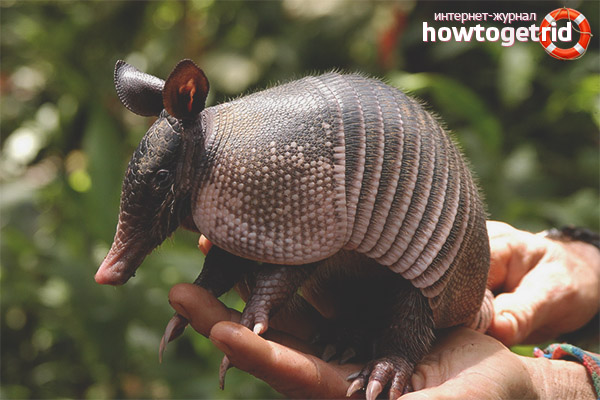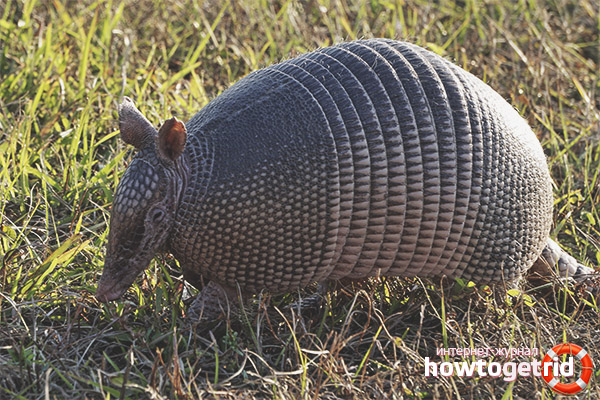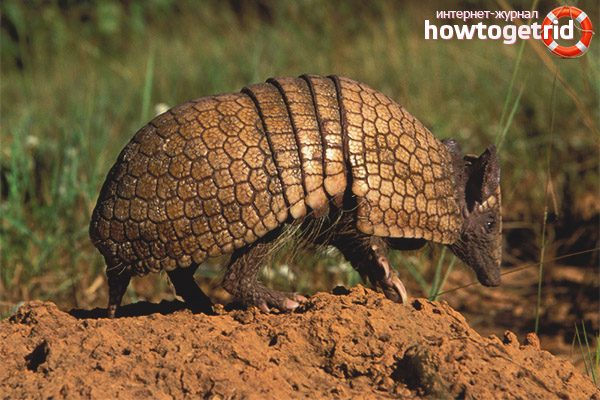The content of the article
The battleship is a very ancient and rather strange mammal, preserved from the time when the Earth was inhabited by dinosaurs. It used to be that an animal wearing such a tough, durable carapace is the closest relative of the common tortoise, but then zoologists changed their minds. Nowadays, armadillos are considered to be in the same order of placental mammals, which includes sloths and anteaters.
Altogether, 20 species of these ancient animals inhabit the Earth. They are very similar to each other, differing from each other only in their habitat, size, lifestyle and other minor details.
Description
The ancestors of the battleships ran around the Earth 55 million years ago. These were huge, heavy creatures that instilled fear and horror on rivals. At the present time, they chopped and become smaller. Since ancient times, the local inhabitants have fixed the nickname "armadillo" for animals, which translates as "he who wears the shell."
The strong carapace is the first to be seen when looking at these animals. It serves as a protection against harsh predators and helps armadillos to get through prickly shrubs without damaging the body. The carapace is formed from skin ossifications, it is a thick plate, covered on the outside with a keratinized epidermis. Strong and wide shields cover the shoulder area and hips, located in 3 zones. Soft tissue connects them together - this makes it possible during periods of danger, in the manner of a hedgehog, to curl up and take the form of a ball. Some species do not collapse, but simply hide under the paw guards, snuggling tightly to the ground. And not a single enemy, even with strong teeth and sharp claws, can reach.
The shell is usually painted in the color of the surrounding area, the color varies from yellow to dark brown. There are species wearing pink shells.
The length of the body hidden by the shell is in the range of 80-150 cm, the tail is from 30 to 40 cm, and the weight is 6 kilograms. The muzzle is long and elongated, the ears are tubular, similar to pork, are next to each other.
Nature did not reward armadillos with good eyesight - it is very weak. But there is a developed sense of smell and excellent hearing, helping to navigate in space and find prey.
The limbs are quite short, but powerful and developed. On the back - five long fingers equipped with claws, on the front (depending on the type) - from three to five fingers.
Lifestyle
Most species prefer to stay awake at night, sleeping during the day. But it also depends on age. Suppose young individuals live actively in the morning and even in the afternoon. And with the onset of cold weather, they can switch to a fully daily regimen.
Animals are mainly solitary, but sometimes there are couples living together, and sometimes whole families of armadillos. For the most part, animals sit or sleep in underground burrow-shelters, leaving the surface only at night, in order to get food.
By the presence of holes in the ground, it is easily determined that armadillos live in this area. On the occupied area, they dig holes at a depth of half a meter to five with many corridors going in different directions. Usually animals do not live in excavated shelters for long - the battleships do not feel affection for the house, therefore they can, finding themselves far from the old house, find an anthill or termite mound and dig a new shelter nearby, covering it with grass and dry leaves.When it rains and water falls into the hole, the litter gets wet, and the battleship changes it to fresh. Often, not far from the hole you can see a bunch of rotted rotted leaves.
Food
The basis of the diet is insects. First of all, ants of any kind and termites. When searching for food, animals slowly walk along the ground, sniffing and raking the ground and foliage with their paws.
There are species awarded with powerful claws, with which they destroy stumps with ants and termite mounds, and then with the help of a long tongue they collect and send prey to the stomach. Sometimes at the same time other individuals eat 30-35 thousand insects.
The nine-belted battleship belongs to those rare species who are not afraid to eat red ants - the so-called "firefighters". He patiently endures painful bites by digging up an ant hill and eating the larvae.
In the summer, the bristled armadillo eats carnivorous food (insects, frogs, lizards and rodents), and in the winter it diversifies with a plant diet. They love armadillos and fruits (for example, persimmons), they are happy to absorb snakes and gaping lizards. Nor will they pass by the birds' eggs lying in the nest of birds nesting on the ground.
Armadillos reach puberty in the second year of life. In the summer (depending on the habitat and species), it is time for marriage ceremonies and games. The males look after the females for a long time, stubbornly pursue them until they get consent to the relationship.
Most species are ready for breeding only once during the whole year. Pregnancy is quite long - 60-64 days. Such a long period is explained by the fact that the fetus stops in development for some time. No more than four cubs are born - it depends on the species. Kids are born sighted and with a very soft shell, hardening with age. For 15-17 days, the mother feeds the babies with milk (those unable to feed eat the offspring), after which they begin to get to the surface and get used to the adult diet.
Enemies
For all their excellent outdoor protection and invulnerability, armadillos, however, have enemies capable of handling the beast. The main and worst include coyotes, lynxes, cougars, alligators, jaguars and bears. Some species of birds of prey are also dangerous. Representatives of the younger generation are especially affected - the body is covered with a soft, uncured shell, and even its small size does not allow it to withstand the enemy.
A lot of battleships suffered from ordinary cars. Not even from the fact that the poor animals were under the wheels. The fact is that with fear, the animal jumps sharply up. Caught under a colliding car, the animal succumbed to the triggered reflex and a considerable number of armored carriers crashed to death on the bottom of the car.
Saving Armadillos

People have long been preparing meat dishes from battleships. And in the 21st century, Hispanics consider meat to be a delicacy. Since the animal does not run away from danger, but only hides under armor, it is defenseless before a person. Yes, and many animals died due to the fact that they cut down forests. And farmers destroyed the animals because they dig the land very much. Six species are listed in the International Red Book.
Varieties
- Seven-belted battleship. Likes to live in arid areas, found in Paraguay, Brazil, Bolivia and Argentina. He lives on the surface of the earth, does not like companies and leads a solitary life. This species gives birth to many children - up to 8 pieces (sometimes 12) of the same sex.
- Southern long-nosed. Lives in South America in Paraguay, Brazil, Uruguay and Argentina. He is also not a fan of companies, he shows activity both day and night - it depends on temperature, weather conditions and time of year.
- Kappler's battleship. Lives in Ecuador, Colombia, Suriname, Peru and Bolivia. Unlike the previous species, it gravitates to high humidity - it digs holes near small rivers and wetlands. Also solitary, awake at night.
- Hairy. Lives in the southwest of the Andes in Peru, loves woodland and on hills - up to 3000 meters above sea level.
- Carnivorous. Distributed in the western part of Argentina, as well as in the surrounding areas of Bolivia. The smallest of the battleships is a body length of only 14-16 centimeters, a tail - about 3 centimeters, a body weight of only 85-90 grams. Lives among shrubbery and cactus thickets or in deserts. It also digs holes and underground passages, feeds on ants and eats the larvae of various insects. It comes to the surface very rarely, since there it is very clumsy and absolutely helpless.
- Thyroid. Lives in the savannah shrubbery of Paraguay. Also of small size, the length is 15 centimeters, the tail is short - about 4 centimeters.
- Small bristly. Lives in Bolivia, Paraguay, Chile and Argentina. It inhabits all types of landscape - plains with and without shrubs, desert terrain, pastures, plantations cultivated by people. Propagated in the fall. There may be several litters during the year. The female walks pregnant until 75-80 days, two heterosexual children are born. The weight of the newborn is about 110 grams, feeding lasts about 60 days. It becomes sexually mature at the tenth month of life.
- Big bristly. Lives in the highlands (up to 1250 meters) of Argentina and Peru. Prefers grass savannas and pampas. Length - almost half a meter, weight - up to 3 kilograms. Nocturnal resident, a female gives birth twice a year, pregnancy about two months. Two heterosexual children are born.
- Dwarf. It lives in areas from southern to central Argentina. The body is about 30 centimeters long, the tail is 13 to 15 centimeters long. Prefers daily life, lives in holes. Food - worms, ants and invertebrates. In a litter of up to two children, it becomes sexually mature at the 10th month.
Video: Armadillo (Cingulata)











Submit